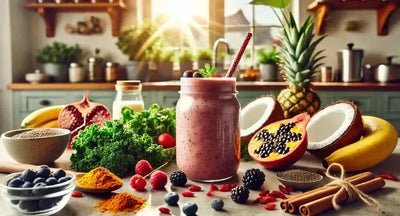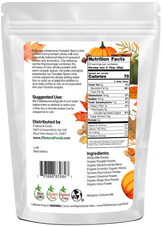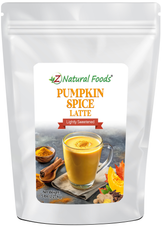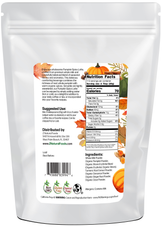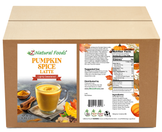Description
Description
The autumn season brings with it a surge in popularity for pumpkin spice-flavored products, particularly the delicious pumpkin spice latte.
Just walk into any coffee shop or bakery in the fall season and the air is loaded with the smell of fantastically warm and cozy cinnamon, clove and pumpkin spices.
This trend has sparked interest not only in the delicious flavor but also in the potential health benefits of the spices that comprise this seasonal blend.
Today, we explore the common ingredients and some possible health implications of the delicious pumpkin spice latte.
So, What’s Really in Your Pumpkin Spice Latte?
While this seasonal favorite brings warmth and comfort to many, it's worth taking a closer look at its nutritional profile and what’s really inside our beloved pumpkin spice latte.
Most people assume that the pumpkin and spices in a pumpkin spice latte are packed with health benefits. But how true is that?
Today, this is exactly what we dive into.
Let’s get started!
How many calories are in your favorite Pumpkin Spice Latte?
A typical 16-ounce pumpkin spice latte from a popular coffee chain contains approximately:
- 390 calories,
- 14 grams of fat,
- 50 grams of sugar, and
- 14 grams of protein[7].
To put this into perspective, the American Heart Association recommends limiting daily added sugar intake to 25 to 36 grams[8]. Yet a single pumpkin spice latte can easily exceed this.
Although high in calories and sugar, the presence of healthy fats and protein in this beverage may make it a better choice than you think, especially if you're using a quality milk base.
After all, a healthy source of fat and a quality source of protein can potentially be a benefit to almost any beverage, including your pumpkin spice latte.
And depending upon the quality, 14 grams of fat and 14 grams of protein may help make this a better choice. This is at least one important reason why the milk base matters.
So, in addition to the macronutrients such as fats, carbohydrates and protein, because of the choice of milk or milk substitute used, a standard pumpkin spice latte can be a treasure trove of many wonderful nutrients, such as nourishing fatty acids, vitamins, minerals and other unique compounds.
After all, the superstar nutrients are from the milk and pumpkin. These two foods alone are incredibly rich sources of vitamins, minerals and unique nutrients.
So, depending upon what type of milk base used and how the pumpkin flavor is produced, will largely determine how much nutrition you actually can gain.
But more about the milk base and pumpkin in a moment.
Let’s first review what most people try to avoid; too much sugar.
The sugar content in most pumpkin spice lattes is a primary concern for most experts because excessive sugar consumption has been linked to weight gain, obesity, increased risk of type 2 diabetes, and worse[9].
You know this already.
But you may not be aware of at least one of the additional ingredients lurking in most commercially produced pumpkin spice lattes.
This ingredient to pay special attention to is called “natural flavors”.
Whether you love them or not, the term ‘natural flavors’ is a common ingredient in many popular foods and drinks, including pumpkin spice lattes.
This ingredient is used for a variety of reasons.
- First, as the name implies, ‘natural flavors’ intend to provide a concentrated natural-tasting flavor.
- Additionally, natural flavors may be potentially lower in calories as compared to other flavoring options.
- Natural flavors may provide more flexibility for the manufacturers in their product development endeavors.
- Lastly, and possibly the most important issue is that manufacturers are likely aware that the term ‘natural flavors’ implies to consumers that these flavors are somehow naturally extracted from pumpkin, coconut, cacao or blueberry, etc., in order to deliver the appropriate flavor.
But, in reality, natural flavors are typically a complex mixture of chemicals.
- Plus, they provide little to no transparency of what the natural flavors actually are.
- Additionally, natural flavors are often highly processed, and
- All this further contributes to misleading labeling practices as these natural flavors may still contain synthetic compounds and significant processing.
- After all, who knows what these synthetic compounds could be doing to gut health, the microbiome, inflammation, food cravings, and general well-being.
For these reasons, and many more, we work very hard at Z Natural Foods to avoid the use of “natural flavors”.
With that, let's get into the best parts of a well made pumpkin spice latte;
- The nutritious milk base options,
- The delicious pumpkin flavor and
- The incredible spices.
Dairy and non-dairy options for the milk base in your Pumpkin Spice Latte
Today, you have almost an endless number of choices to create the perfect, fully customized pumpkin spice latte based on your unique tastes and nutrition goals.
For example, you can choose from a plethora of milk base options.
After all, it is a latte.
Your choice can range from a variety of traditional milk options, including whole milk, low fat milk, or non fat milk. You could probably also choose lactose free milk or even opt for goat milk.
Or, you can also choose from a variety of non-dairy, plant-based options such as almond milk, oat milk, coconut milk, or soy milk.
For this example, let’s review a couple benefits of what a standard whole milk option may provide.
A brief review of Whole Milk as the base for your Pumpkin Spice Latte
We hear all the time that milk does the body good.
Whole full-fat milk and foods derived from it are not just a good source of calcium but also a quality source of protein and nourishing fatty acids.
One of the many nutritional qualities of whole milk is that it offers a unique blend of fast (whey) and slow-digesting (casein) proteins, allowing for maximal use of this essential macronutrient.
Additionally, when done right, the majority of your nutrition, including the calories, protein, carbohydrates and fat in a superior pumpkin spice latte will probably come from the whole milk.
This is exactly the scenario in our Pumpkin Spice Latte powder mix, which features nourishing traditional whole fat milk from USA farms as the milk base – providing the broadest source of calories and nutrition in the latte blend.
Alternatively, if you prefer almond milk, oat milk, soy milk, or coconut milk to be the base in your pumpkin spice latte, the nutrients can be excellent as well, based on your preference and your nutrition goals.
The star ingredient in your favorite Pumpkin Spice Latte: Pumpkin
Sadly, many pumpkin spice latte recipes don't use any actual pumpkin at all.
Many of these latte producers rely on a mix of spices to create the "pumpkin spice" flavor.
In this case, the "pumpkin" flavor often comes more from the spice blend (typically including cinnamon, nutmeg, ginger, and cloves) rather than from a large quantity of actual pumpkin.
Sounds like an odd way to enjoy a pumpkin drink, doesn’t it?
This is not to say there aren’t some very high quality pumpkin varieties used in popular pumpkin spice lattes.
In fact, one of the most popular brands has been using a real pumpkin puree for decades.
Another popular brand chooses to use a canned pumpkin puree for their pumpkin flavors.
While this is great news and kudos to the best brands selling pumpkin spice lattes, unfortunately, most of these well known brands also use a variation of “natural flavors” to further enhance the taste and texture profile of their pumpkin spice lattes.
So now you can at least be aware of natural flavors and if they fit your goals.
Whole pumpkin is a treasure trove of nourishment and provides its own real, natural flavor
Let's face it; no one wants to eat something that tastes terrible or has an unappealing texture.
If this was the case, any Pumpkin Spice Latte seller delivering a bad tasting experience would quickly go out of business.
But when used correctly, changing the flavor of a food or beverage is one area where magic can happen.
This is where Z Natural Foods truly shines, and why we chose to use our Organic Pumpkin Powder to provide not only the true pumpkin flavor, but also be the second biggest source of nutrition in our Pumpkin Spice Latte next to the whole milk.
Again, when developed properly your pumpkin spice latte should not only taste great, but should provide at least some quality nutritive value.
And in the case of our Pumpkin Spice Latte, our Organic Pumpkin Powder delivers the familiar taste and nutrition you’d expect.
In fact, pumpkin and other nourishing foods of color contain a wide array of compounds that have been verified by research to benefit human biochemistry. Each one of these foods has a superstar compound that they are known for containing.
The superstar nutrient in the colorful pumpkin is the family of compounds known as carotenoids
Carotenoids are a class of red, orange, or yellow fat-soluble pigments produced by plants, algae, and photosynthetic bacteria. There are more than 600 types of carotenoids (some of the most common include alpha and beta carotene, lycopene, lutein, and beta-cryptoxanthin), all with unique attributes that are researched for their potential ability to take on antioxidant-like qualities.
Nutrients like this are almost perfectly preserved in Z Natural Foods’ Organic Pumpkin Powder – which, again, is the feature ingredient in our Pumpkin Spice Latte.
It’s this kind of incredible nutrition that you simply can’t get from a laboratory developed chemical cocktail that might also be labeled as a natural flavor.
Nothing beats a real, whole, delicious pumpkin to be the star of your Pumpkin Spice Latte.
Let’s now add some delicious fall spices into our mix.
After all, it's the incredible spices in the perfect ratios that make your pumpkin spice latte extra flavorful and may provide some added nutritional value.
The spices that make your Pumpkin Spice Latte a seasonal favorite
The classic pumpkin spice blend that flavors your latte typically consists of a blend of cinnamon, ginger, nutmeg, and cloves[1].
And some blends, such as Z Natural Foods’ Pumpkin Spice Latte includes Turmeric Root Extract (Curcumin) for an added nutritional boost.
Typically, as a high calorie drink often featuring nearly 400 calories and up to 50 grams of added sugar, the pumpkin spice latte itself may not be the healthiest choice when compared to other options.
But, the individual spices usually used in a pumpkin spice latte could possibly offer some potential health benefits:
- Cinnamon: Studies have shown that cinnamon may help support a healthy blood sugar response. But is it enough to counter 50 grams of sugar?
- Ginger: Known for its digestive benefits, ginger is widely used to ease discomfort. Can ginger save the day to counter the natural flavors?
- Nutmeg: This incredible spice delivers an incredibly rich and delicious taste and aroma. Mmmmmm.
- Cloves: Researchers show cloves have been investigated for their rich antioxidant properties. Powered by the incredible compound eugenol for its distinct aroma and flavor, just a little bit of cloves goes a very long way.
- Turmeric and curcumin: With nearly 600 potential therapeutic effects, curcumin is touted as one of the most remarkable compounds for supporting a healthy inflammation response due to its unique mechanisms of action. Curcumin remains a focal point of scientific investigation and health discourse.
Each of these spices has been used in traditional medicine for centuries and has been the subject of modern scientific inquiry.
While the usual commercial pumpkin spice latte itself may not offer significant health benefits due to a possible high sugar and calorie content, the individual spices in the blend have been associated with various positive health effects[2].
In conclusion, while the individual spices that make up pumpkin spice have demonstrated various positive health effects in scientific studies, their impact in the context of pumpkin spice-flavored products is absolutely critical – and totally delicious – but their nutritional benefit may be significantly limited because of the relatively small amounts in each beverage.
A Healthier Alternative: Z Natural Foods’ Pumpkin Spice Latte
For those who love the flavors of fall but want to make the healthiest choice possible, Z Natural Foods is proud to release their nourishing and delicious Pumpkin Spice Latte.
Featuring all the goodness of whole milk, whole organic pumpkin, a careful balance of familiar, delicious and nourishing spices, lightly sweetened but with no added sugars and only 70 calories per serving, Z Natural Foods’ Pumpkin Spice Latte could be one of the healthiest and most delicious latte’s you’ve ever tasted.
For more information about this wonderful seasonal beverage, go here:
Pumpkin Spice Latte (Lightly Sweetened)
Bibliography:
- Cleveland Clinic. "Benefits of Pumpkin Spice." Health.clevelandclinic.org, October 23, 2023. https://health.clevelandclinic.org/pumpkin-spice-benefits.
- Allen, Robert W., Evan Schwartzman, William L. Baker, Craig I. Coleman, and Olivia J. Phung. "Cinnamon Use in Type 2 Diabetes: An Updated Systematic Review and Meta-Analysis." The Annals of Family Medicine 11, no. 5 (2013): 452-459.
- Mashhadi, Nafiseh Shokri, Reza Ghiasvand, Gholamreza Askari, Mitra Hariri, Leila Darvishi, and Mohammad Reza Mofid. "Anti-Oxidative and Anti-Inflammatory Effects of Ginger in Health and Physical Activity: Review of Current Evidence." International Journal of Preventive Medicine 4, no. Suppl 1 (2013): S36.
- Moinuddin, Ghulam, Kshama Devi, and D. Hanumanthachar Khajuria. "Evaluation of the Anti-Depressant Activity of Myristica fragrans (Nutmeg) in Male Rats." Avicenna Journal of Phytomedicine 2, no. 2 (2012): 72.
- Cortés-Rojas, Diego Francisco, Claudia Regina Fernandes de Souza, and Wanderley Pereira Oliveira. "Clove (Syzygium aromaticum): A Precious Spice." Asian Pacific Journal of Tropical Biomedicine 4, no. 2 (2014): 90-96.
- U.S. Food and Drug Administration. "Part 101 - Food Labeling." In Title 21 - Food and Drugs, Chapter I - Food and Drug Administration, Department of Health and Human Services, Subchapter B - Food for Human Consumption. Electronic Code of Federal Regulations. Last updated September 22, 2024. https://www.ecfr.gov/current/title-21/chapter-I/subchapter-B/part-101.
- Starbucks Coffee Company. "Pumpkin Spice Latte: Nutrition Facts." Accessed October 29, 2024. https://www.starbucks.com/menu/product/418/hot/nutrition.
- American Heart Association. "Added Sugars." Accessed October 29, 2024. https://www.heart.org/en/healthy-living/healthy-eating/eat-smart/sugar/added-sugars.
- Yang, Quanhe, Zefeng Zhang, Edward W. Gregg, W. Dana Flanders, Robert Merritt, and Frank B. Hu. "Added Sugar Intake and Cardiovascular Diseases Mortality Among US Adults." JAMA Internal Medicine 174, no. 4 (April 2014): 516-524. https://jamanetwork.com/journals/jamainternalmedicine/fullarticle/1819573.
